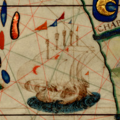Fichier:Javanese or Sundanese jong in China Sea, from Miller Atlas of 1519.png
Javanese_or_Sundanese_jong_in_China_Sea,_from_Miller_Atlas_of_1519.png (266 × 432 pixels, taille du fichier : 284 kio, type MIME : image/png)
Historique du fichier
Cliquer sur une date et heure pour voir le fichier tel qu'il était à ce moment-là.
| Date et heure | Vignette | Dimensions | Utilisateur | Commentaire | |
|---|---|---|---|---|---|
| actuel | 3 novembre 2019 à 09:15 |  | 266 × 432 (284 kio) | Verosaurus | {{Information |description ={{en|1=Cropped portion of China Sea, showing 2 large ships, one is six-masted and the other one, being shown from the aft, showing 3 masted ship (there could be more since the sails obstructed the front masts). Since it's showed inaccuracies with the description of Malay junk of the time, the image is clearly an attempt to depict a large Malay junk.}} |date =1519 |source =Lopo Homem-Reineis Atlas or Miller Atlas |author =Lopo Homem, Pedro... |
Utilisation du fichier
La page suivante utilise ce fichier :
Usage global du fichier
Les autres wikis suivants utilisent ce fichier :
- Utilisation sur en.wikipedia.org
- Utilisation sur es.wikipedia.org
- Utilisation sur id.wikipedia.org
- Utilisation sur ms.wikipedia.org
- Utilisation sur mt.wikipedia.org
- Utilisation sur uk.wikipedia.org
- Utilisation sur zh.wikipedia.org



